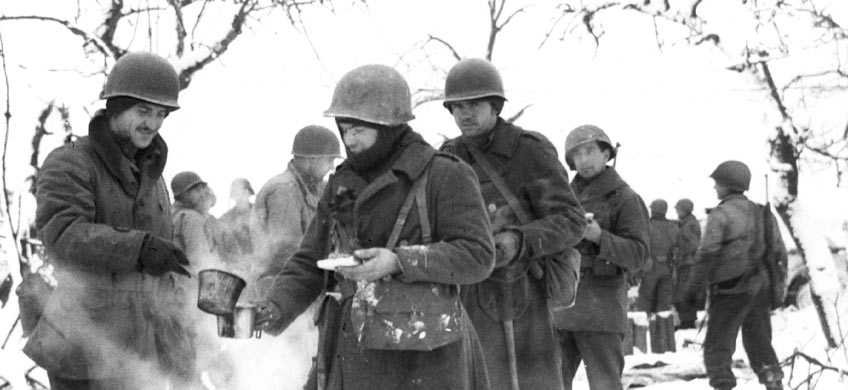
(page 4 of 4)
As the Allied offensive swept across France, Watson reported from Soissons, “The farther one advances in this dazzlingly swift campaign the clearer is the evidence of the demoralized state of the enemy. Our infantry and artillery have been able to move in the armor’s trail, consolidating its gains and establishing a firm wall to block the enemy’s retreat.” In the same issue of the newspaper, McCardell reported that engineers building advance airfields for the Ninth Air Force had been hard put to keep up with the advancing front. “The construction battalions now are leapfrogging each other. Their reconnaissance teams are well beyond Paris in the race to keep the fighter-bombers on the heels of our armored columns and motorized infantry now rolling toward the German border.”
A new theme crept into Watson’s reportage in mid-October when he was writing about Aachen—this time not as a military objective waiting to be taken but as a German city now under the occupation control of American forces. Here was a great opportunity, he wrote [Oct. 15, 1944] to demonstrate how the U.S. would administer conquered territory and populations. “Our performance in that stage is inevitably being witnessed by the Germans in the immediate area and their impressions are inevitably being communicated in one way or another to millions of Germans in the cities which lie on the other side of the combat line.” Occupation control must serve the military campaign, he asserted, citing the old army dictum that “one of the prime requisites for success in the forward areas is orderliness in the rear.” Watson estimated there were still 10,000 German civilians in Aachen who had defied Nazi orders (obeyed by 150,000 others) to evacuate the city. Some were the likeliest candidates “to accept our domination” having gone through a screening process whereby “a good many dubious sheep and undoubted goats” have been left in prison camps. To perform police duties, 80 persons had been selected as “reliable” and had been outfitted with new uniforms—blue jackets and red-striped pants—that drew the envy of the populace.
Nazis had long boasted they had brought order out of chaos after coming to power in the early ’30s. Watson wrote: “If now the American administrators can demonstrate that they, too, can and without savage oppression likewise establish and maintain civilian order, there will be a political victory which, in after effects, may prove commensurate with the military victory itself.” The Sun’s military expert said the Army’s program might not satisfy Americans who think “every German should be exterminated” or others who believe convinced Nazis will “immediately yield to generous treatment and become reformed characters.” “The Army is following a middle path which seeks to separate known goats from potential sheep. They are endeavoring to keep the goats isolated to provide the sheep with an opportunity to demonstrate their tractability and their willingness to live at peace with the world.” In assessing damage in Aachen, Watson reported that while many water mains were shattered, schools were more in need of teachers than repairs.
During this optimistic period before the storm, Day and McCardell came up with vignettes mocking the Germans. Day told of a trio of would-be deserters, one of whom had a safe-conduct pass that had been dropped on enemy positions. But there was a problem. “They understood that they had only one ticket among them. Could they surrender on that, or should they go back and get two more?” McCardell described a German veteran of World War I who had attempted to surrender but his commanding officer was a “stinker” who would execute his whole squad to prevent defections. The vet defected anyway and, “ironically enough,” in the same locality where he had surrendered in the last war.
There would be precious little time or inclination for Allied troops to belittle the German enemy in the grim weeks ahead.
Excerpted from Combat Correspondents: The Baltimore Sun in World War II, published by the Maryland Historical Society in cooperation with the Johns Hopkins University Press.
